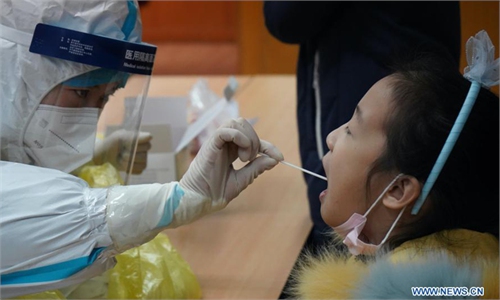Hebei builds 3,000 makeshift facilities for quarantine amid surging COVID-19 infections

Villagers took a designated bus to quarantine centers in Shijiazhuang, N China’s Hebei Province, on January 11. Photo: VCG
Hebei reported another 81 newly confirmed cases and its first death registered on Wednesday, health authorities said on Thursday.
The construction site of the centralized quarantine venue is about 500 mu (33.3 hectares) in size and will provide 3,000 housing units for COVID-19 patients.
According to the integrated housing providers based in the city of Tangshan, each unit is 18 square meters in area and uses a light steel structure, which has the advantages of convenient transportation, rapid installation, and recyclability.
Reporters saw some 100 people and dozens of pieces of engineering equipment enter the empty land site on Wednesday. When China Railway 14th Bureau Group received the order to build the housing units on Wednesday, they immediately started work at the construction site on the same day in Shijiazhuang's Zhengding county, Xinhua reported.
After the completion of the infrastructure, 3,000 integrated housing units will be quickly assembled on the site. These integrated houses are being shipped from the city of Tangshan to Zhengding county and are expected to arrive within three days.
The housing units have sufficient supporting facilities, water and electricity pipelines, and can be put into use immediately when they reach Zhengding. The parts can be assembled by skilled workers in one day.
The integrated housing providers from Tangshan took part in the building of Wuhan's Huoshenshan makeshift hospital in early 2020.
Since Monday, after the clustered infections of the district's Xiaoguozhuang village turned the entire district into a high-risk zone, the local authority of Shijiazhuang started moving 20,000 villagers from 12 villages of the epidemic-stricken Gaocheng district to other townships for quarantine.
The Global Times learned from some locals and experts that imposing quarantine for confirmed, asymptomatic cases and close contacts is key to preventing the virus spread. Villages are unable to fully implement such quarantine measures, which is why the local government mobilized them to quarantine at designated places, where the villagers will get proper care.
Qi Shunxiang, an official from the Hebei provincial center for disease prevention and control, said home quarantine in villages will make it easy for other family members and neighbors to contract the virus. The level of hygiene practiced by villagers is also not appropriate for quarantine.
Designated quarantine for those patients is their best option, and ensures the complete elimination of the source of infection, Qi said.
Amid surging infections, cities and provinces have begun sending assistance to Hebei, such as teams specializing in nucleic acid testing, epidemiological investigations and medical treatment.
Global Times



